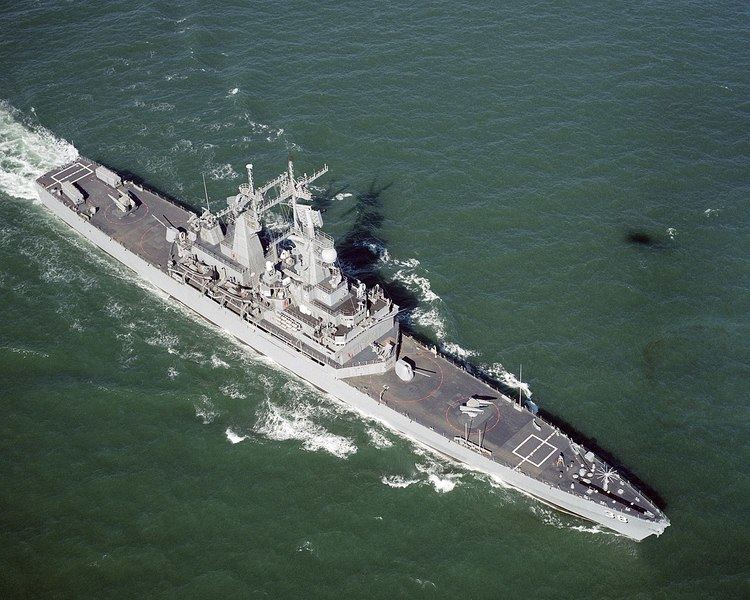Preceded by California class | Succeeded by Ticonderoga class | |
 | ||
Cost $675 million (1990 dollars) | ||
The Virginia-class nuclear guided-missile cruisers, also known as the CGN-38 class, were a series of four double-ended (with missile armament carried both fore and aft) nuclear-powered guided-missile cruisers commissioned in the late 1970s to 1980, which served in the United States Navy until the mid-to-late 1990s. They were the final class of nuclear-powered cruisers completed.
Contents
The ships had a relatively short service lives. As with any nuclear powered ship, they were expensive to operate. The class was just coming up for their mid-life reactor refuelings just as the 1994 Defense Authorization Bill was being formulated, which would impact cuts of 38% to the Navy's budget, compared to the 1993 bill. The $300-million-plus cost of each refueling and other upgrades made the class easy targets for decommissioning. Each ship was therefore retired starting with Texas in July 1993 and ending with Arkansas in 1996, and each ship went through the nuclear vessel (ships and submarines) decommissioning and recycling program.
Class description
The ships were derived from the earlier California-class nuclear cruiser (CGN-36 class). Three of the four Virginia-class ships were authorized as guided missile frigates (in the pre-1975 definition), and they were redesignated as cruisers either before commissioning or before their launching. The last warship, Arkansas, was authorized, laid down, launched, and commissioned as a guided-missile cruiser. A fifth warship, CGN-42, was canceled before being named or laid down.
With their nuclear power plants, and the resulting capability of steaming at high speeds for long periods of time, these were excellent escorts for the fast nuclear-powered aircraft carriers, such as the Nimitz class. They also had had excellent flagship facilities. Their main mission was as air-defense ships, while they also had capabilities as anti-submarine (ASW) ships, surface-to-surface warfare (SSW) ships, and in gun and missile bombardment of shore targets. The Virginia class as designed carried two LAMPS helicopters, aft of the superstructure with a flight deck, and in a unique arrangement among the U.S. Navy the hangers were below-decks, an improvement over the preceding California-class which only had only a landing pad aft and basic refueling equipment.
It was found that, while it was possible to mass-produce nuclear-powered warships, the ships were less cost-efficient than conventionally powered warships. Also, the new gas turbine–powered ships then entering the fleet—the Spruance-class destroyers—required much less manpower. While eleven ships of the Virginia class were planned, only four were produced and the remainder were cancelled. Following the completion of the final member of the class, Arkansas, the U.S. Navy continued conventional destroyer/cruiser production, and it re-designated the DDG-47 class of guided missile destroyers as the CG-47 Ticonderoga-class cruisers.
Early decommissioning
All four vessels were decommissioned as part of the early 1990s "peace dividend" after the Cold War ended. The early retirement of the Virginia-class cruisers has been criticized by some. They were new, modern ships; given a New Threat Upgrade electronics overhaul, they would have been well-suited to modern threats. They had rapid-fire Mk 26 launchers that could fire the powerful Standard SM-2MR medium-range surface-to-air missile—earlier decommissioned cruisers used the slower-firing Mk-10 launchers, which required manual fitting of the missiles' fins prior to launch.
Nevertheless, the CGN-38-class cruisers, with their missile magazines and Mk-26 missile launchers, were incapable of carrying the SM-2ER long-range surface-to-air missile, being restricted to the SM-2MR medium-range surface-to-air missile. This was a significant limitation in their capabilities. Another weakness was the loss of LAMPS helicopters, due to the installation of Tomahawk cruise missile launchers.
In the end, what really doomed the Virginia nuclear-powered cruisers was economics. They were coming due for their first nuclear refuelings, mid-life overhauls, and NTU refittings, which were all expensive projects, together costing about half the price of a new ship. Further, they required relatively large crews, straining Navy personnel resources. The 1996 Navy Visibility and Management of Operating and Support Costs (VAMOSC) study determined the annual operating cost of a Virginia-class cruiser at $40 million, compared to $28 million for a Ticonderoga-class cruiser, or $20 million for an Arleigh Burke-class destroyer, the latter two classes designed with the much more capable Aegis Combat System. Given a lower requirement for cruisers, it was decided to retire (this decision was made while Texas was in the middle of her refueling overhaul) these nuclear ships as a money-saving measure. The early Ticonderoga-class cruisers which lacked the Vertical Launch System had equally short careers, serving between 18 and 21 years.
